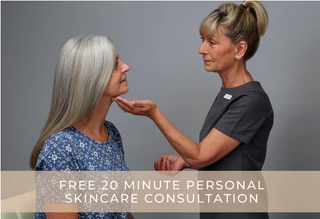This could be why...
Are you confusing dehydrated skin with dry skin? Many people do. For optimal skincare results, remember that dehydrated skin lacks water, while dry skin lacks oil. In this blog, we refer to water as either water or moisture.
How do you know if you have dehydrated skin…
We all have an element of skin dehydration. It’s a skin condition. Skin conditions happen because of your lifestyle, the environment you live in and climate. It is not your genetic skin type.
Another reason your skin gets dehydrated is when your skin barrier is compromised, allowing precious moisture (water) loss. Damage may be caused by harsh, aggressive products or by following a poor skincare regime.
How to recognise your dehydrated skin?
The signs of dehydration present on your skin’s surface. The problem is it can often be mistaken for an oily shine.
As I said, if your skin barrier is compromised it is not able to fully do its job, which is to keep the ‘good stuff’ in (water and oil) and the ‘bad stuff’ out (dirt, pollution, bacteria). The later of the two issues means there is less protection from the outside world. The first of the two issues is where the confusion lies in how to treat your skin.
Underlying congestion is often a problem too. Stagnant toxins are trapped within your cells, without the fluids to self-flush and clean. Underlying congestion often develops into spots.
The pores on a dehydrated skin are open and because of the lack of water they are grey at the base. The open pores and damaged barrier allow moisture and oil to escape onto your skin’s surface. The two mixed feel like a light oily fluid and present as a shine part way through the day.
Lifestyle factors such as caffeine, alcohol, inadequate water intake, central heating, air conditioning, lack of sleep and certain medications impact skin hydration levels, contributing to the misconception of dehydrated skin as oily skin.
This is why dehydrated skin is often mistaken for oily skin.
This often leads to the use of unsuitable, harsh, skin stripping products. These harsh products damage your skin barrier even more. Making the problem worse.
Mistaking grey dehydrated pores for blackheads.
Remember, dehydrated pores are open. The base of your open pores are grey in colour, this makes your skin look dull and can often be mistaken for blackheads.
The grey colour is easily flushed away with the correct skincare ingredients. Whereas blackheads are plugs of oil and debris which when removed are a dense, compact oil build up.
Not all open pores are a sign of skin dehydration.
It’s worth noting that open pores can be genetic or part of the ageing process of your skin. However, if your skin takes on a sallow, grey look in areas, check your open pores. If they look dark at the base, your skin is likely to be dehydrated.
Correcting a dehydrated skin condition.
It’s important to get into good habits with your skincare regime.
A good cleansing routine in the morning and evening will help to keep your pores clean and prevent them from becoming unnecessarily blocked.
It’s likely that your skin barrier will need a little TLC. It’s time to go back to basics and rebuild a strong, healthy skin barrier.












